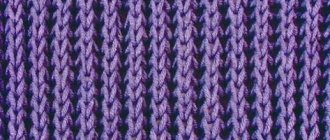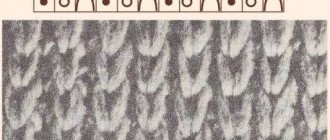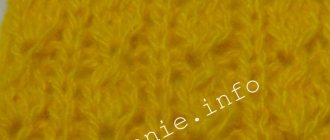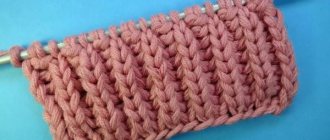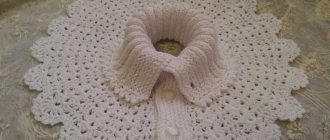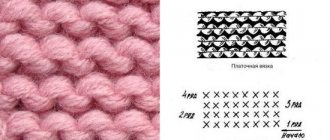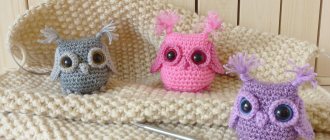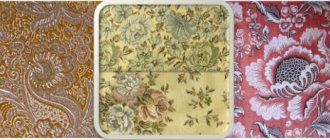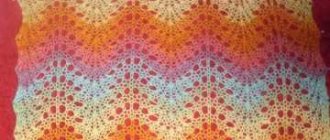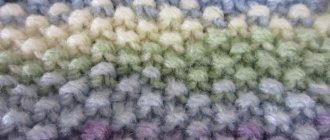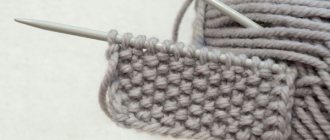The ability to knit opens up a new world of creativity in which you can come up with different knitted items and even create unique gifts for family and friends. A novice needlewoman may find knitting difficult and time-consuming. Don't give up. Each knitted loop will help make knitting easier and simpler.
French rib is used to knit scarves, skirts, children's clothes and other products in which the corrugated component of the pattern is important. It is also often used to decorate sleeves, bottom and top of the product. With its help, you can decorate a knitted item in an original and new way.
There are several options for knitting French rib. In addition to them, you can try other “foreign” versions of rubber bands, for example, American, Bulgarian and English.
French elastic with a report of three loops
It consists of two rows that repeat each other. The main difference from other types of elastic bands is that the loops cross each other. In this case, in each front row, the front loops are crossed, and in each purl row, the purl loops are crossed.
The loops do not need to be removed onto an auxiliary needle, as when knitting a pattern with braids. First, the second loop is knitted, then the first, after which the two knitted loops are removed onto the right knitting needle. So the loops need to be crossed in each stitch and in each row, which requires more time and effort than when knitting simpler types of elastic bands. When knitting such an elastic band in the round, you need to take only loops that are multiples of three, without an edge or additional loop.
The French elastic with a report of four loops differs from the previous method only in the number of purl loops between the braids of crossed loops.
Video with master class lessons on knitting French rib using knitting patterns
French elastic band No. 1
Video tutorial on knitting a variant of the pattern described in article No. 1.
French elastic band No. 2
Video tutorial on knitting a variant of the pattern described in article No. 2.
French elastic band No. 3
Master class on knitting a variant of the pattern described in article No. 3.
French elastic on circular knitting needles
Video tutorial on knitting French elastic using knitting needles using a knitting pattern in the round.
Hat for winter and autumn
The video shows in detail how to knit a cozy autumn-winter hat that will fit your head not tightly, but very softly.
Hat with lapel
Master class on making a fashionable hat using a French rib knitting pattern.
Fashionable snood
Video demonstrating how to make a luxurious fashionable snood.
Beautiful scarf
Here you can learn how to knit a great scarf with a piquant zigzag pattern.
Original twist
Video tutorial on how to knit an elegant headdress with your own hands, which can also be used as a scarf.
Simple hat with ears
A master class on knitting a simple cute hat with ears using circular knitting needles, without a seam.
Classic faceted French gum
Externally it has a corrugated texture. At the same time, knitting it is much easier than French elastic. It is often used as an independent pattern for knitting children's clothes and various types of accessories, such as hats and scarves.
This elastic band is knitted in two rows, which alternate with each other. The loops of the pattern are shifted. The number of loops should be divided by four, plus one loop for symmetry, plus two edge loops.
In the first row, after the edge stitch, two knit stitches and two purl stitches are repeated, followed by a knit stitch. In the second row there is a change of two purl and two facial loops, at the end of the row a purl loop is knitted.
Knitting such an elastic band is quite simple, because the loops in it alternate, like in a regular two-by-two elastic band. But its characteristic feature is that in each row the loops must shift. Due to this, beautiful folds are formed, creating an original texture. When knitting faceted French rib, you should always remember:
- You should always cast on loops with an odd number;
- each row begins with an edge loop, which must be removed and not knitted;
- The first stitch after the edge stitch should always be knitted;
- after the first loop, the inner part of the row is always knitted alternating two purls and two knits;
- each row should end with one purl edge loop;
- Before the last purl loop there must be two knit stitches. This must be taken into account when calculating the number of loops.
French and American elastic knitting - even a beginner in knitting can handle it
At first, it may seem that knitting with a French rib is not so easy. However, if you understand the pattern, then even a novice needlewoman can cope with such a pattern - you only need to master two rows, which alternate during the knitting process.
In appearance, the pattern resembles “corrugation”, so it is often used in knitting children’s skirts and as a trim. Looks great on a hat, snood and even mittens!
This elastic band is knitted by alternating two knit stitches and two purl stitches and looks very impressive and beautiful. Crossing the loops is done in each report - in the front rows 2 front loops are crossed, and in the purl rows - purl loops.
Scheme No. 1
The first loop is knit in the front row and purl in the back row, the second loop is knit, the third loop is knit in the back row and purl in the front row, the fourth loop is purl in all rows.
1st row – * knit 2, purl 2 *, repeat from * to *, knit 1;
2nd row – * purl 2, knit 2 *, purl 1.
Scheme No. 2
Pattern report 3 loops + 1 loop for symmetry + 2 edge loops (not shown in the diagram), repeat the pattern from the 1st to 2nd rows.
1st row: * 1 p., 2 cross. persons loops (without removing the 2nd loop from the left knitting needle, knit behind the back wall of the front one, then knit the 1st loop and remove both to the right knitting needle)* repeat from* to* the required number of times and finish row 1 purl;
2nd row: k1, * p2. crossed (first knit the 2nd purl loop, thread before work, then knit the 1st purl stitch), k1. P.*;
If you want to knit such a pattern in a circle, then use only report loops, without additional or edge loops. Also, when knitting in a circle, the pattern of the 2nd row will change, namely:
1st row: * Purl 1, cross 2. persons loops (without removing the 2nd loop from the left knitting needle, knit behind the back wall of the front one, then knit the 1st loop and remove both to the right knitting needle)* repeat from* to* until the end of the row;
2nd row: *P1, cross 2 persons loops (without removing the 2nd loop from the left knitting needle, knit behind the back wall of the front one, then knit the 1st loop and remove both to the right knitting needle)* repeat from* to* until the end of the row.
Scheme No. 3
Pattern report 4 loops + 2 loops for symmetry of the pattern + 2 edge loops
1st row: 1 purl, * 1 purl, 2 cross. persons loops (without removing the 2nd loop from the left knitting needle, knit behind the back wall of the front one, then knit the 1st loop and remove both to the right knitting needle), purl 1*, repeat from * to * the required number of times and finish row 1 purl .;
2nd row: k1, * k1, p2. crossed (first knit the 2nd purl loop, thread before work, then knit the 1st purl stitch), k1. p.*, 1 person.p.
Repeat the 1st and 2nd rows until the desired length is reached.
Scheme No. 4
Classic Polish elastic with a corrugated structure for knitting children's clothing and various accessories.
American gum
American ribbing has a beautiful raised pattern, making it great for knitting sleeve cuffs, socks and hats.
Scheme
The pattern report is 3 loops +2 edge loops, repeat the 1st and 2nd rows of the pattern in height according to the diagram:
1st row: *Knit 2, purl 1*, repeat from * to * until end of row;
2nd row: *Knit 1, yarn over, knit 2 stitches and pulled through the yarn over.
Polish gum
Canadian gum
Ethiopian gum
American gum
This type of elastic looks especially impressive in a product knitted from light-colored yarn. The pattern itself is textured and quite dense.
You need to knit an American elastic band as follows:
- Two knit stitches must be alternated with one purl stitch, repeating this combination until the first row is completed.
- Knit one, yarn over one, knit two stitches and pull into yarn over.
Although the pattern may seem complicated, it can be quickly memorized and easy to knit.
English gum
This type of elastic gives volume to the loops, as a result of which the knitted fabric gains good elasticity, has a beautiful texture and excellent stretch. It can be used not only to process the edges of the product, but also as an independent design for the entire thing. For example, for scarves, snoods and hats.
Advantages of English gum:
- beautiful texture, allowing you to create an exquisite canvas even in a large product;
- good elasticity;
- the splendor and looseness of the pattern, thanks to which the canvas turns out warm.
The disadvantages include the greater consumption of yarn compared to a regular elastic band and the need to knit several rows with a simple elastic band before starting to work with an English elastic band.
An English elastic band consists of knit and purl loops, with a yarn over added to them and the loops thrown over it without knitting. The number of stitches cast on must be odd. This is important in order to create a neat edge to the canvas.
Simple hat
The hat is knitted entirely with a snake elastic band. As a result, it turns out to be loose and will not suit those who do not like such hats. The product can be decorated with a pompom, then you need to take into account that it will pull the hat back. To prevent this from causing inconvenience, you can use an elastic thread. The product is knitted so that it does not stretch, otherwise the pattern will not be noticeable. When knitting with a French rib, the usual stitch cuts are not made. In this case, the crown is closed by tightening, so it is better to take yarn of medium thickness.
To work you will need yarn, for example, pekhorka, knitting needles No. 4, 5, sewing needle, scissors, elastic thread, cardboard or a special device for making a pompom.
Let's look at the job description.
Related Article: Short Sleeve Pullover
For a hat with a head circumference of 60 cm, cast on 119 stitches and knit 62 rows using a French elastic according to the pattern above. In the last row, reduce the number of loops by skipping 1 purl stitch and 2 stitches together with the knit stitch. This will tighten the fabric a little. Next, close the last row, sew the hat with a connecting seam, pull the crown together, and sew on a pom-pom. At the end, use a needle to pull the bobbin elastic through the first row, pull it a little, and secure the ends. The hat is ready!
You can buy a pompom ready-made or use a special device to make it. Or you can do it yourself using improvised means. Wrap threads around a rectangular piece of cardboard and pull them tightly on both sides. Remove from the cardboard, pull it in the middle, cut the edges, trim with scissors.
Another master class on knitting a hat:
Bulgarian gum
To knit a Bulgarian elastic band, you need to cast on so many loops so that their number is divisible by six. To the resulting number you need to add two edge loops.
The first row begins with an edge loop, then knitting two knit and two purl loops is repeated until the end of the row. In the second row you need to knit two facial loops, perform one yarn over. Then knit two more knit stitches and then yarn over them. Thus, you need to repeat knitting until the row is completed. The third row is knitted like the first, the second row like the fourth, and so on.
